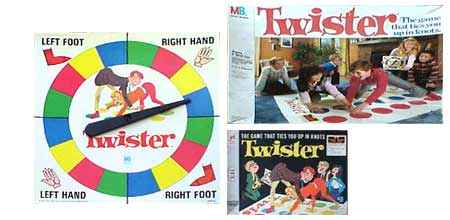Twister

Synopsis of Toy
“The game that ties you up in knots.”
It grabbed the attention of millions of viewers when Johnny Carson played it with Eva Gabor on his late night talk show in 1966, and “Weird Al” Yankovic has written a song in its honor. You can’t get more pop out of your pop culture than that. It’s Twister, folks, and this little number can be a G-rated game for kids or a PG-13 rated flirty little adult romp—the rules are the same, it’s just the innuendo that changes.
In the mid-1960’s, a sales promotions whiz named Reyn Guyer had been hired by a shoe polish company to develop a premium to be used in a mail-in-and-win-a-prize campaign. Guyer had been playing around with an idea for colored patches that went on kids’ feet and an accompanying foot grid. After concocting a giant walkaround grid and delighting his office mates who gave the grid its first trial runs, Guyer thought his idea would make a better game than a giveaway prize. The grid game was christened “Pretzel,” and Guyer’s newest career incarnation—that of toy inventor—took shape. And the same mind that brought you Pretzel would also bring the you original Nerf ball, by the way—so don’t go thinking Guyer was any one toy trick pony.
Guyer’s Pretzel was gobbled up by Milton Bradley, who re-christened the game as Twister. Two to four players could pretzel-ize themselves at a time, and it wasn’t like there were reams of small-printed, head-scratching game instructions to read through. Open the box and you were faced with just two things: a large vinyl mat that you had to unfold, and a spin-board. The players themselves were the game pieces, which meant no pawns, pegs, tokens, chips or dice. Nothing to lose, and nothing for the dog to swallow.
Players took turns spinning the plastic arrow around a small board with four quadrants—right leg, left leg, right arm, left arm. If your arrow landed on a green square in the “Right Leg” corner, for example, you located the green spot that was the most bodily possible for you to reach, and you went for it.
The game’s first stages were simple—perhaps just a slight stretch to the side or an easy bend in one your still-relaxed limbs. But as the game wore on and the other players’ bodies spread out over that grid, reaching the dot wasn’t always a walk in the park. Best case scenario, heads would turn to admire your graceful act of bodily contortion (“Look at her go! Those yoga classes are really paying off!”). Worse case: terrible, terrible proof that you and the word ‘pliant’ were never going to be found in the same sentence. Joints creaked, backs cracked, sweat collected on brows, and odd positions were held for ungodly lengths of time—held that is, until they could be held no more. The first player to collapse and topple, of course, was the loser. But since he usually brought all the other players down with him, even the winners didn’t have a lot of time to gloat.
The game was initially marketed toward teenagers, and sales were not what you would call swift. Milton Bradley worried that the idea behind the game—the players as the game pieces idea—wasn’t quite the buzzer-sounding, lights-flashing, million-dollar concept they had hoped. But then on May 3, 1966, Johnny Carson stepped in. Well, he sort of climbed in, actually, climbing over and around a low-cut-dress-wearing Eva Gabor while his studio audience went berserk. Needless to say, television’s first on-air Twister bout sparked an adult consumership that Milton, in its wildest marketing meeting dreams, never expected. It became a nothing short of a 1960’s toy craze.
Play it at parties or home, play it indoors or out, play it with family or your “just friends,” or your “slightly more than just friends” or the apples-of-your-eye that you hope someday to be “definitely much, much more than just friends.” Any way you play, it's plenty of knotty (and borderline naughty) fun.
